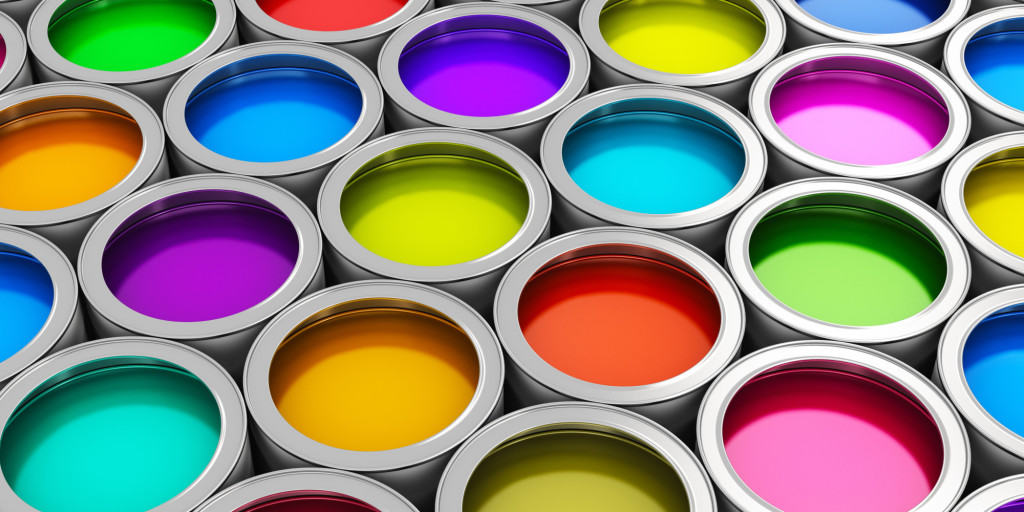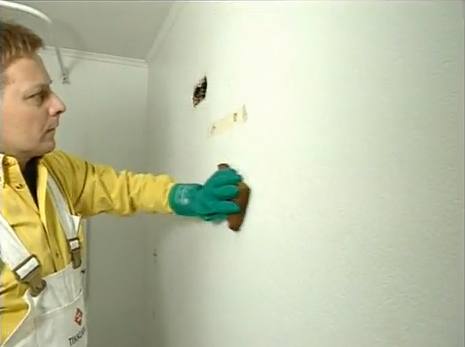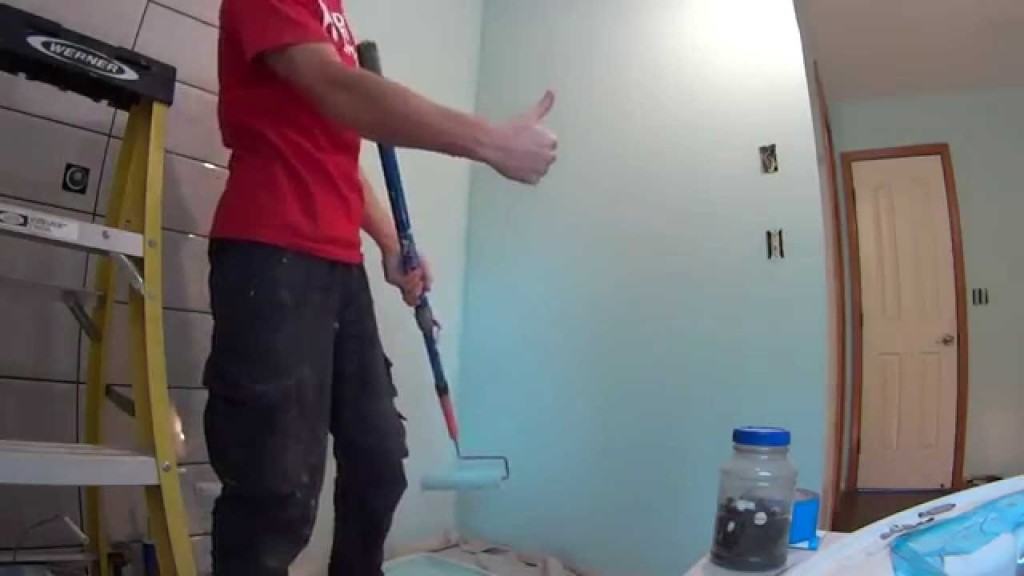How and what is bathroom painting done
Painting a bathroom is no big deal. You just need to follow some rules and take your time. The most important thing is to decide how to paint the inside of the bathroom, because it's a humid environment and you won't be recoating every year.
After that, it is also necessary to apply a high-quality coating, because this will affect both the appearance and durability. These are the questions we will consider today. Also on the video in this article you can learn a lot of additional useful information.
If the family budget does not allow you to purchase for, then you can always find an alternative. Yes, and specialists involved in facing work, take quite a lot of money for their services.
Paint is a great substitute for tiles. First, we decide how to paint the bathroom at home.

Attention: The appearance of the bathroom with a careful approach to painting will be no worse than after tiling. It is quite possible to paint on your own. The main problem here is very high humidity, so streaks and numerous stains can appear on the walls.
Such premises are more prone to mold than others, which adversely affects human health. To prevent unpleasant moments, painting the walls with protective paints will help.
Before buying paint, be sure to carefully read the information on the label. First of all, it should have a mark on the permission to use paint in the bathroom.
You should also pay attention to the class of paint:
- Waterproof– designed for coatings interacting with water;
- Water repellent- designed for coatings that interact with steam.
Today on the shelves of hardware stores there is a wide range of different paints suitable for painting bathrooms.
| Waterproof acrylic paint | It has good resistance to sunlight, is not subject to peeling and cracking, easily tolerates treatment with household detergents, and has excellent adhesion characteristics. The disadvantages of this type of paint include low adhesion to plastic surfaces. Some brands of paint, when dry, can dramatically change color. |
| Water based paint | Prevents the formation and development of fungal infections, does not form blisters when interacting with water, is not subject to yellowness. The disadvantages include the fact that the paint is not suitable for metal surfaces, as it promotes corrosion. |
| Alkyd enamel | It has good elasticity and durability, very fast drying. When dried, alkyd enamel does not turn yellow, does not change color, does not form irregularities. Also, it can be added to the pluses that the paint perfectly tolerates cleaning with detergents and effectively protects metal surfaces from corrosion. The disadvantage of enamel is its unpleasant odor. |
| It has increased resistance to water and various kinds of pollution. The disadvantages of this paint are primarily its high cost. | |
| silicone paint | It has excellent wear resistance, has excellent hygienic characteristics, and is resistant to household chemicals. The downside is its high price. |
So:
- When choosing a paint, it must be remembered that water-based paints, after drying, have a more presentable appearance than their oil counterparts.
- For bathrooms, glossy paint is well suited, since its drying period is quite short, it does not tend to crumble and is resistant to external factors.
Attention: It is desirable that one of the ingredients of the paint is a fungicidal solution. It prevents the spread of mold and fungal infections in rooms with high humidity.
Some nuances when choosing paint
Bathroom painting options can be quite different, a lot depends on your imagination.
- For the bathroom, it is recommended to choose a paint with high moisture resistance, since it is there that all surfaces are more susceptible to the negative effects of moisture than in other rooms. A good addition to the paint ingredients is the presence of fungicides and algicides. These are substances that prevent the formation of fungal and mold lesions on the walls.
- An excellent solution for bathrooms is water-based paint. It is distinguished by high resistance to moisture and the absence of yellowness. Water-based paint gives the walls a smooth matte finish, dries quickly enough. An important point is the absence of unpleasant odors. Currently, the stores offer a huge selection of moisture-resistant paints.
- In the bathroom, it is recommended to choose a neutral color scheme. The color of the paint should be combined with the main elements of the decor. To visually increase the area of the bathroom, it is recommended to paint it in light colors. They have the ability to visually increase the space of the room. For a bathroom with an impressive area, rich dark colors are perfect. Black, green, rich blue walls and snow-white washbasin, shower or bath will contrast with each other, which will give the room an exquisite originality.
- For the bathroom, it is preferable to use acrylic water-based paints containing latex. They do not harm health, tolerate treatment with detergents well, and dry quickly enough. The main argument in favor of these paints is their high resistance to water and high humidity. If there are difficulties with the acquisition of paint of the desired color, then it can be achieved independently. To do this, you just need to add the color of the desired shade to the white paint. It must be mixed into the paint either by hand or by mechanical means.
- The color scheme in the design of the bathroom depends entirely on the individual wishes of the owner of the room. It is he who decides whether to paint the walls in pastel colors or prefer bright colors. Today, the option of decorating walls with various kinds of drawings and graphic images is very popular. They can be applied with your own hands, including all your imagination. If there is no hope for your artistic talents, then you can use stencils. The most popular are abstract patterns, drawings with a marine theme, images of various colors.
Do-it-yourself bathroom painting is done in a certain sequence and in compliance with the technology. Below is an instruction that will help you do everything efficiently. When working, only high-quality materials should be used, their price is higher, but they will last much longer.
Preparing walls for painting
Bathroom painting begins with surface preparation. This is the first step and it is extremely important. If this work is not done correctly, then the appearance will not be attractive and you will not have to think about durability.

Preparatory work should be done in three steps:
- You need to start by removing the previous layer from the surface of the walls (old tiles or paint). Paint can be removed using an ordinary spatula.
- At the second stage, puttying is performed (see). It is necessary to use a material with high resistance to moisture, as the bathroom is characterized by high humidity. An excellent solution would be to use a water-based dispersion putty containing latex. First, the putty is applied to the roughness in order to achieve a leveling of the surface.
- Then proceed to puttying the entire wall from the bottom up. The third step in the preparatory work is the priming of the walls. The primer material for the bathroom must have high moisture insulation and penetrate deep into the wall surface. Almost the entire range of soil is distinguished by its versatility.
Once the primer is completely dry, you can start painting.
Attention: It should be noted that the ceiling is painted first, and then they start painting the walls.
What you need
Before starting work, you need to stock up on the necessary equipment.
For painting you will need the following tools:
- Different size brushes for coloring in corners and places with limited access;
- Paint roller.
If the surface to be painted occupies a significant area, then the roller should be chosen large, for smaller surfaces a narrow one is suitable. With the help of rollers with a long pile, you can make the surface of the walls textured, and for painting with an even layer, the pile on the roller should be short.
General instructions for painting walls
Bathroom painting is done in stages. After choosing the material and preparing the walls, the dye must be applied correctly and efficiently.

So:
- It is necessary to paint the walls after the work on painting the ceiling has been done. If you neglect this rule, then when painting the ceiling, it is easy to stain the already painted wall surface.
- Painting work should be started only after complete drying of all previous coatings. Be sure to wait a day after applying a layer of soil. For painting, the use of a roller is recommended. The size of the roller is directly dependent on the area of the surface to be painted. The smaller the surface, the more you need a roller. The use of a roller makes it possible to obtain various effects on the painted wall. To form a smooth surface, you need to choose a roller with a short pile, and to give a textured finish, you need a roller with a long pile. To qualitatively paint corners, joints and hard-to-reach places, it is best to use brushes of different sizes.
- First of all, they begin to paint the wall from the upper corner, where the junction of the wall and ceiling is located. It is better to paint in small areas, the width of which should be the width of two or three rollers. In order not to stain the ceiling during painting, it is recommended to seal it with masking tape.
- The paint on the surface of the walls in the bathroom must be applied as evenly as possible. To obtain a uniform and uniform coating, painting the surface, you can not apply great effort when pressing on the roller. The movements should be fairly light.
- Painting the walls in the bathroom is carried out in two layers. The first layer creates the desired color background on the wall surface. The second layer ensures that the wall is completely painted and the desired shade is achieved. The second coat of paint is recommended to be applied without waiting for the first coat to dry completely. It should be remembered that in the room where the painting is done, no drafts should be allowed. If present, painted surfaces dry unevenly.
- When painting the walls in the bathroom, it must be taken into account that the first layer must be applied horizontally, and the second layer vertically. If you do the opposite, then the paint will not be distributed on the surface correctly, creating the effect of unpainted walls.
Attention: It may turn out that the old layer of paint does not have fungal and mold foci, has retained a fairly decent appearance, only slightly yellowed from the adverse effects of water and excess moisture. In this case, you can update the appearance of the walls by covering them with a layer of paint of the same color as before.
- For this, ordinary water-based paint is used. First you need to prepare the walls for painting work, and then you can start painting. This painting option does not require the release of surfaces from old paint. It is enough to treat the walls from rust stains or wash them with soapy water. It is very important that the walls dry thoroughly before painting. After drying, you can proceed to the staining procedure.
- For many, the bathroom is not only a place for bathing and personal hygiene, but a place for a pleasant stay. After all, here, basking in warm water, you can think about the past day and plan the next day. That is why it is important to create a cozy atmosphere in the bathroom, conducive to complete relaxation.
How to paint the bathroom you will now understand, look at the photo and select the desired coating. A bathroom painted with paint is not a complicated process, but a responsible one.






